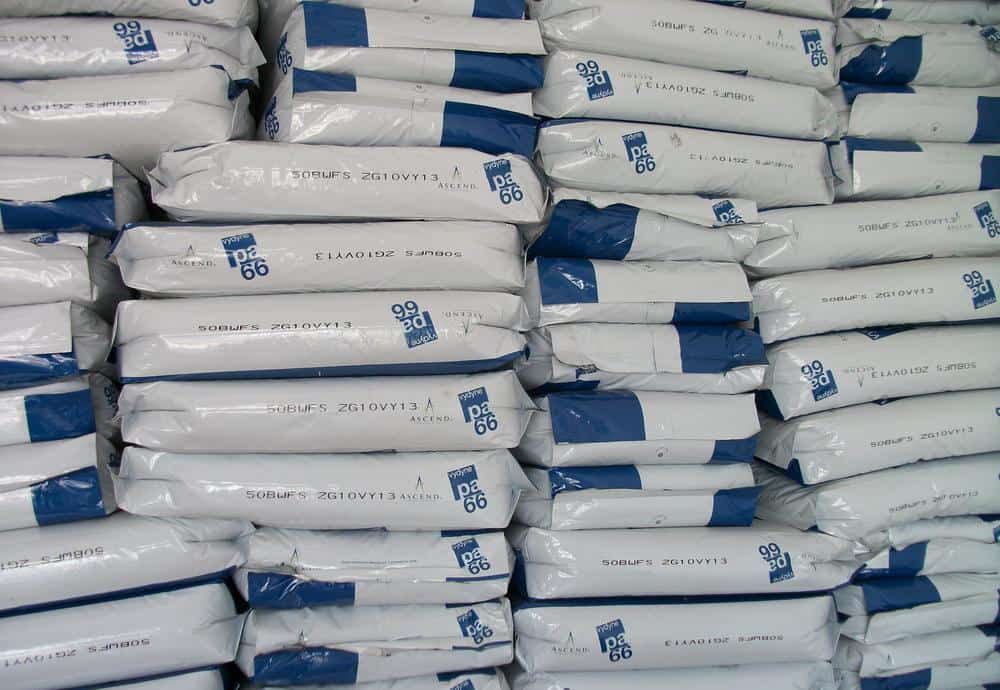
Nylon (polyamide, abbr.as PA) refers to a injection molding plastic composed of polyamide resins, which can be obtained by polycondensation of diamines and dibasic acids, or by ring-opening polymerization of lactams formed by dehydration of amino acids. Different from PP, PE and PS, PA Nylon does not gradually soften with the rise of temperature, but softens within a narrow temperature range close to the melting point that is obvious, i.e., 215-225 °C. It flows as soon as the temperature is reached.
There are many types of PA, mainly including PA6, PA66, PA610, PA11, PA12, PA1010, PA612, PA46, PA6T, PA9T and MXD-6 aromatic polyamide, etc., and the commonly used nylons are PA6, PA66, PA610, PA11, and PA12.
The characteristic of PA Nylon
The nylon engineering injection molding plastics all appear as keratinous, tough, super bright, white (or milky white) or yellowish, and transparent or translucent crystalline resins, which are easily colored into any color. As an engineering plastic, the molecular weight of nylon generally ranges from 1.5 to 30,000. Their density is slightly greater than 1. Density: 1.14-1.15g/cm3; tensile strength: > 60.0Mpa; elongation: >30%; bending strength: 90.0 MPa; notched impact strength: (KJ/m2) > 5. The shrinkage rate of nylon is between 1% and 2%. Pay attention to the dimensional change caused by moisture absorption after molding. Water absorption rate is 100%, and it can still absorb 8% at relatively saturated humidity. The nylon material can be used at temperature conditions between -40 and 105 °C, with a melting point of 215-225 ° C and a suitable wall thickness of 2-3.5 mm. The mechanical properties of nylon, such as tensile and compressive strengths, change with temperature and moisture absorption, so water is a plasticizer for nylon. After glass fiber is added, its tensile and compressive strengths can be increased by about 2 times, while thermal resistance is also improved. Accordingly, the nylon material itself has a very high resistance to wear, so it can be continuously processed without lubrication. If you want a special lubricating effect, you may add some sulfide to the nylon material.

Nylon plastic injection molding conditions
| Drying | Since nylon material is prone to moisture absorption, we need to guarantee its dryness before injection molding production. When the material is shipped or delivered in waterproof packages, the containers should be tightly sealed. |
| Melting Temperature | 230 – 280 degrees Celsius (446 – 536 degrees Fahrenheit); 250 – 300 degrees Celsius (482 – 572 degrees Fahrenheit) for reinforced nylon grades |
| Mold Temperature | 80 – 90 degrees Celsius (176 – 194 degrees Fahrenheit). The mold temperature has a significant influence on the crystallinity level of the material, which in turn greatly influences its mechanical properties. For parts which require a high degree of crystallization, like structural parts, the recommended mold temperatures are 80 – 90 degrees Celsius (176 – 194 degrees Fahrenheit). As for thin-wall parts with long flow lengths, higher mold temperatures are recommended. Although the strength and hardness will Increase with the mold temperature, the toughness will reduce. If the thickness of the wall is larger than 3 mm, we will recommend a cold mold (20 – 40 degrees Celsius / 68 – 104 degrees Fahrenheit), so as to ensure a higher and more uniform level of crystallinity. For glass reinforced materials, the recommended mold temperatures are always higher than 80 degrees Celsius (176 degrees Fahrenheit). |
| Injection Molding Pressure | Usually between 75 and 125 MPa (depend on PA material types and product design) |
| Injection Speed | High (a little lower for reinforced grades of PA materials) |
The difference between PA6 and PA66
The most commonly used types of nylon are Nylon 6, Nylon 6/6, Nylon 66 and Nylon 6/66. The chemical and physical properties of PA6(Nylon6) are similar to those of PA66(Nylon66), but the former has a low melting point and a wide process temperature range. While featuring better impact and solvent resistance than PA66, it is also more hygroscopic. Since many of the characteristics of a plastic product are affected by hygroscopicity, this should be taken into consideration when designing products using PA6. In order to improve the mechanical properties of PA6, various modifiers are often added, among which glass is the most common additive, and sometimes synthetic rubbers such as EPDM and SBR are added to improve its impact resistance. For products without additives, PA6 shrinks rate from 1% to 1.5%, but the addition of glass fiber reduces the shrinkage rate to 0.3% (but slightly higher in the direction perpendicular to the flow). The shrinkage of the molded assembly is mainly affected by the crystallinity and hygroscopicity of the material. The structure formula of PA6 is ” — [NH-(CH2)5-CO]n — “,PA66 is ” —[NH(CH2)6NHCO(CH2)4CO]n— “
PA injection molding Applications
Nylon PA plastic injection molding is mainly used in the automobile, electrical / electronics, transportation, machinery manufacturing, wire / cable / communications, film and daily necessity industries for production of various bearings, gears, circular gears, cams, bevel gears, oil pipelines, oil reservoirs, protective covers, support frames, wheel covers and deflectors.

